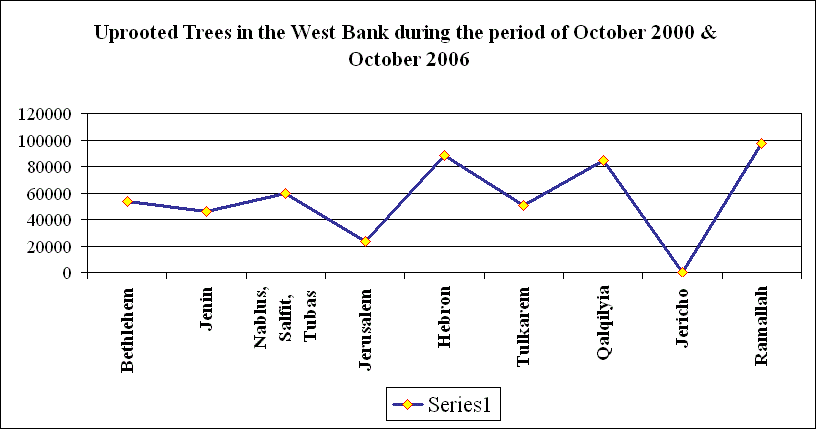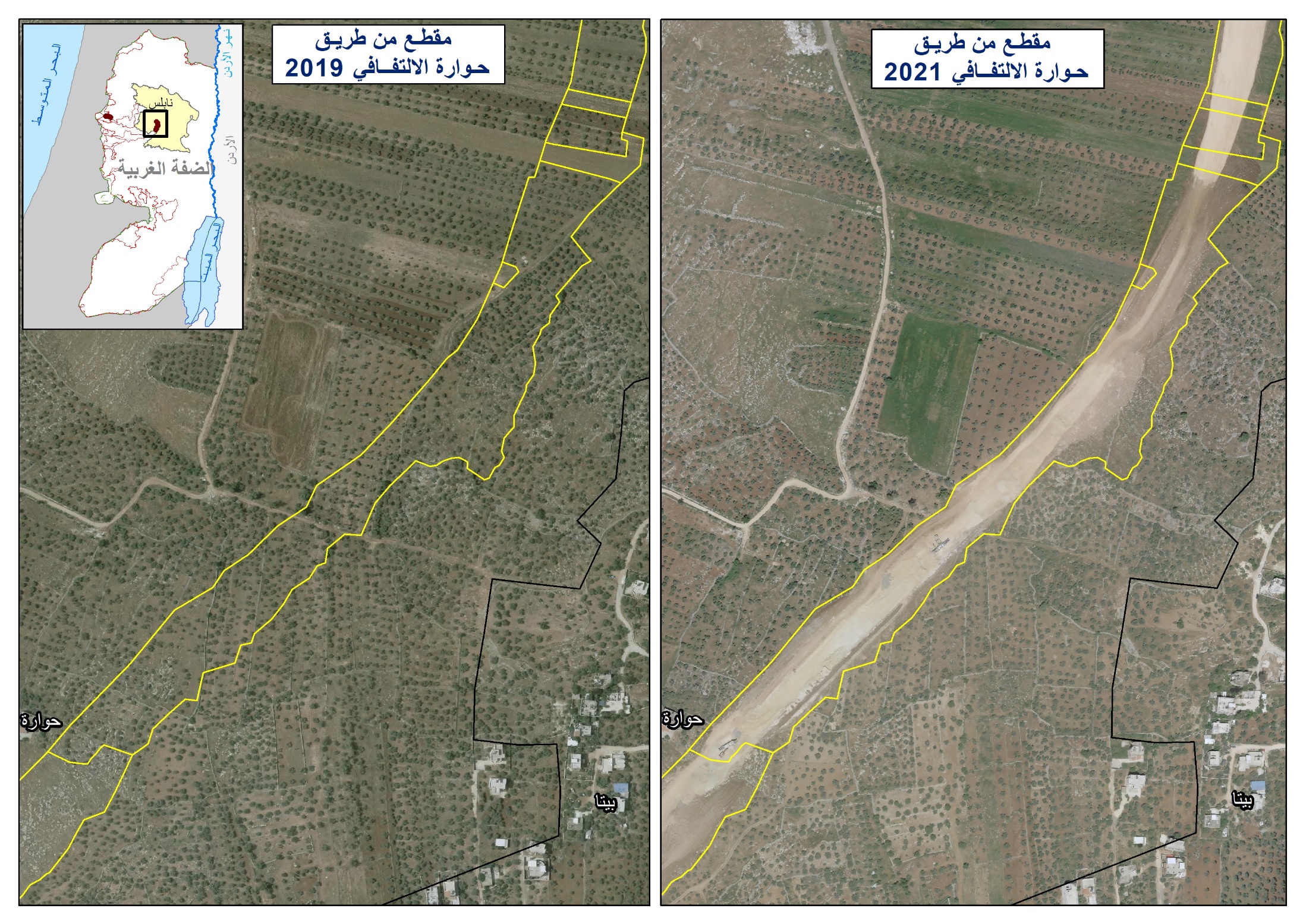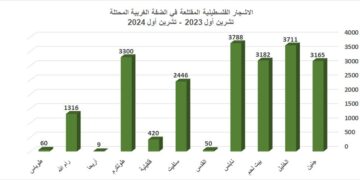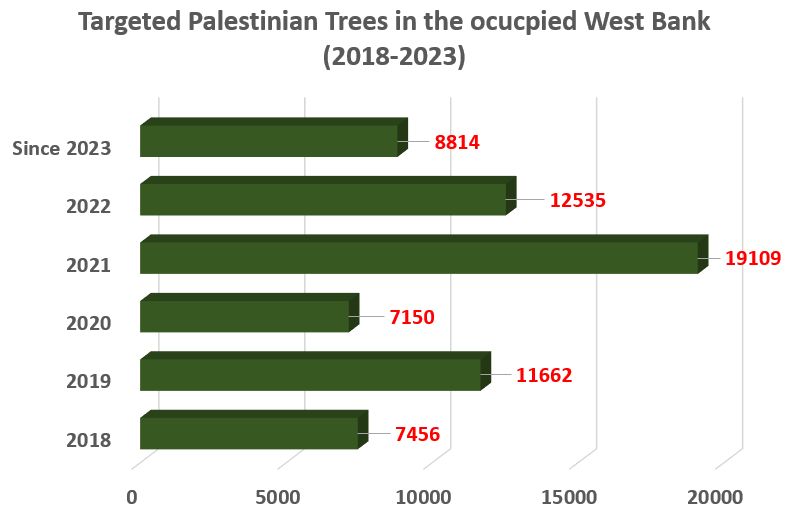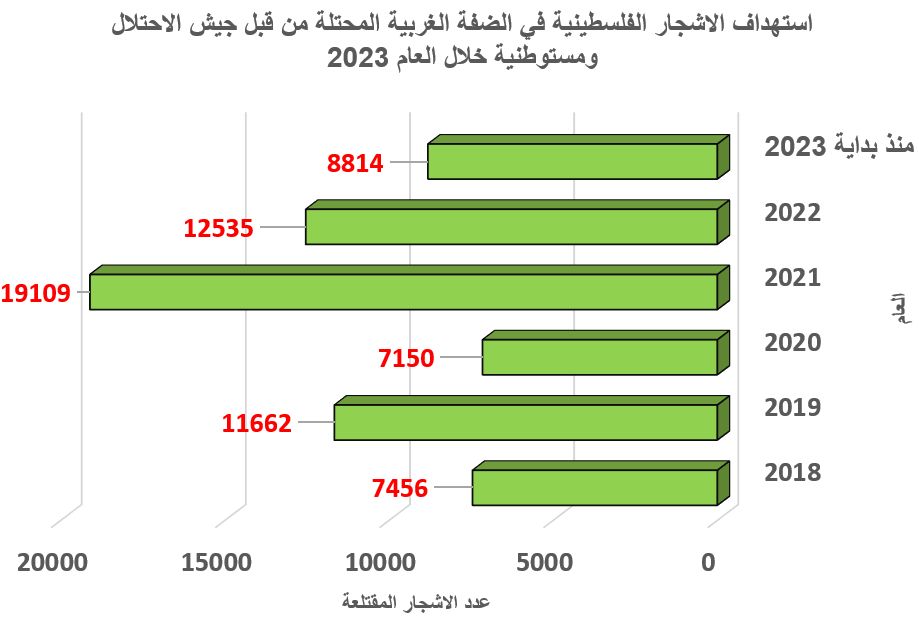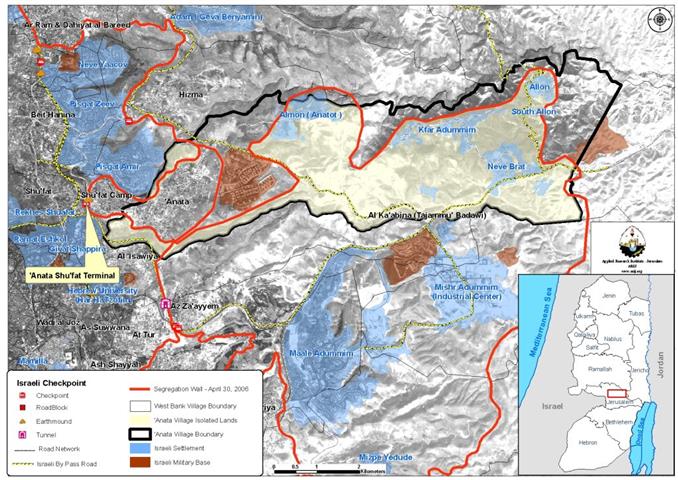Introduction:
Over the past-ongoing 39 years of Israeli Occupation of the West Bank and the Gaza, millions of trees were either uprooted, razed, mowed or segregated from the Palestinian lands to serve the various Israeli goals such as the establishment and the expansion of settlements, construction of bypass roads. Israel also escalated its activities against the Palestinian land and people ever since it started constructing the segregation Wall in June 2002, as the Israeli aggressiveness on Palestinian trees has immensely increase than any time ever before.
In an analysis conducted by the Applied Research Institute during the period between October 2000 and October 2006, the Israeli Occupation Forces and Israeli settlers have confiscated, razed, burnt and destroyed a total of 504503 fruitful trees in all of the West Bank Governorates, most of which were Olive trees. See Table 1
|
Uprooted Trees in the West Bank during the period of October 2000 and October 2006 |
|||||||||
|
|
Governorate |
Oct-00 |
2001 |
2002 |
2003 |
2004 |
2005 |
Oct-06 |
Total by Governorate |
|
|
|
|
|
|
|
|
|
|
|
|
1 |
Bethlehem |
200 |
17860 |
1230 |
27753 |
1340 |
2864 |
2230 |
53477 |
|
2 |
Jenin |
0 |
12050 |
6305 |
15376 |
6115 |
6020 |
50 |
45916 |
|
3 |
Nablus, Salfit, Tubas |
182 |
26546 |
3730 |
3555 |
24787 |
550 |
345 |
59695 |
|
4 |
Jerusalem |
18 |
280 |
445 |
20100 |
1745 |
820 |
0 |
23408 |
|
5 |
Hebron |
1350 |
8480 |
330 |
25840 |
7377 |
34453 |
10448 |
88278 |
|
8 |
Tulkarem |
0 |
16348 |
1300 |
22966 |
7595 |
660 |
2055 |
50924 |
|
9 |
Qalqilyia |
0 |
17204 |
26261 |
28022 |
5019 |
8315 |
0 |
84821 |
|
10 |
Jericho |
0 |
375 |
0 |
0 |
0 |
0 |
0 |
375 |
|
11 |
Ramallah |
5 |
24772 |
3402 |
67323 |
0 |
1607 |
500 |
97609 |
|
|
Total |
1755 |
123915 |
43003 |
210935 |
53978 |
55289 |
15628 |
504503 |
Source: ARIJ Database 2006
This number of uprooted trees had has drastic effects on the Palestinian communities and its economy as Palestinians depend much on Agriculture and the product of these Fruitful trees especially the Olive trees. Click here for more info
Harvesting Olives with tension
During the Olive harvest season, Palestinians living in the different West Bank Governorates faces various Israeli restrictions while trying to harvest their Olive crops, especially those located west of the Segregation Wall or close to Israeli settlements; as the Israeli settlers constantly attack Palestinians while doing their job and/ or set free wild animals to terrify them and prevent them from accessing their lands again.
Several incidents were reported by Palestinians who were terrorized and denied access to their segregated lands behind the Segregation Wall; particularly those who did not have access permits to their lands; Other residents reported that their Olive crops were stolen by Israeli settlers living in the nearby settlements or even were forced to leave their Olive crops in their lands after they were intimidated and harassed by the Israeli settlers. In other cases, even those Palestinians with permits were not allowed to access their lands; as the Israeli soldiers at the so-called agricultural gates denied them entrance. Below is a summary of incidents that took place during the 2006 Olive Harvest Season.
Incidents accrued during the 2006 Olive Harvest Season Month in West Bank Governorates:
-
October 11, 2006 â?? Qalqilyah
The Israeli authorities denied landowners in 'Azun 'Atma village south of Qalqilyah city access to their lands in order to harvest their Olive trees. Wafa (Oct 11, 2006).
-
On October 12, 2006 – Ramallah
Israeli settles from Hismonaim settlement, one of Modi'in Illit Settlement Block (Kiryat Sefer), 10 Israeli settlers attacked three Palestinians who were harvesting their Olive trees.
-
On October 14, 2006 – Tulkarem
The IOF (Israeli offense Army) continued to prevent Palestinian farmers from getting close to Nazlat 'Issa and Qaffin iron gates. Israeli soldiers positioned at gate #436, north of Tulkarm, and prevented Palestinian farmers even those with permits issued by the IOF Civil Administration, claiming that the names and numbers of permits are not registered on their lists. At least 1200 farmers were deprived of their source of income.
-
On October 22, 2006 – Tubas
Israeli Occupation Forces impounded five trucks used for agricultural purposes in Bardala village, north of the Jordan Valley and transferred them to Bisan Crossing point located further to the north. The confiscation of the trucks is one of many procedures that the IOF practice against residents of the Jordan valley; with an intension to drive the people (voluntarily) from their land.
-
On October 25, 2006 â?? Nablus
Confrontations have broken out between Palestinian farmers and Israeli settlers from Gilad Farm outpost; north of the West Bank; as the settlers were trying to prevent Palestinian farmers from picking their olives. Gilad Farm is an illegal outpost located close to the settlement of Keddumim, west of Nablus city.
-
On October 25, 2006 – Salfit
The Israeli authorities prevented Palestinian farmers from Salfit city from accessing their fields through the gates designated by the Israeli Army for that purpose to reach the olive groves located behind the Wall. Residents of Salfit reported that the IOF had the gates closed at all time. The closure of the iron gates caused great loss to the farmers who were not allowed through, thus missing the opportunity to collect their olives crops, which cover thousands of dunums of land and are the source of their livelihood.
-
On October 28, 2006 – Bethlehem
The Israeli Occupation forces fired at Palestinian farmers while harvesting their Olive trees in Jabal Ad Dik area close to Har Homa settlement. It is worth mentioning here that this is not the first time that Israeli soldiers fire at Palestinian farmers while harvesting their olives. Al Quds (October 28, 2006).
-
On October 28, 2006 – Tulkarem
The Israeli Occupation Forces closed the Iron Gate on the Segregation Wall, holding number â??708; located at the western edge of Farâ??oun village south of Tulkarem city, which is the only access to the segregated land west of the wall.
-
On October 29, 2006 – Salfit
The Israeli Occupation forces erected four new iron gates along the path of the Segregation Wall around Salfit City to restrict the access of Palestinian farmers to their segregated lands behind the Wall. Iron Rods of 80 cm high were erected vertically on these gates which forced those willing to access the gates to crawl on the ground to access them. Other than this procedure intentionally aim at humiliating Palestinian farmers, it also prevented farmers from using their agricultural trucks to transport the Olive crops.
-
On October 29, 2006 â?? Qalqilyah
Israeli Occupation Forces continue to deny Palestinian farmers from Beit Amin, Izbat Salman and Siniryia located to the southeast of Qalqilyia city access to their agricultural lands to harvest their Olive trees. It is worth mentioning that the lands are located between the two Israeli settlements Shaâ??are Tekva and Oranit.
-
On October 29, 2006 â?? Nablus
Israeli soldiers manning the Iron Gate set at the bypass road leading to Alon Moreh settlement near Nablus denied residents of Salem village access to their lands to harvest their olive trees. Palestinian residents reported that the Israeli soldiers prevented them from reaching their lands, because of an Israeli settlersâ?? outpost of 4 caravans located at the eastern side of Alon Moreh Settlement was set up near their lands; less than two years when the Army confiscated one thousand Dunums of Palestinian land under the pretext of 'security'.
-
On October 29, 2006 â?? Salfit
Israeli Soldiers in Mas-ha village west of Salfit City (north-west of the West Bank) prevented Palestinian farmers from accessing their fields segregated behind the Segregation wall under the pretext of not having valid permits that enable them to access the gate erected north of the village. Instead, Palestinian farmers were forced to use the gate erected at Azzoun village entrance, which meant for them a 10 Kilometers trip instead of the few hundred meters road to their lands.
-
On October 30, 2006 – Hebron
Israeli settlers from Asfer settlement northeast of Hebron city (south of the West Bank) stole the Olive harvest of 1200 Olive trees of Sai'r and Ash Shoukh towns located west of the settlement. It is worth mentioning that owners of these Lands were prevented for the fifth year on row from harvesting their Olive product by Israeli settlers who attacked them every time they tried to access their lands; all of which being done under the protection of the Israeli Army.
-
November, 2, 2006 â?? Nablus
Israel Forces prevented Palestinian farmers of Dir al-Hatab, near Nablus (north of the West Bank), from harvesting their olive trees in an attempt to prevent a confrontation between residents of the village and residents of the nearby settlement of Elon Moreh, located 1-2 km away from the Olive grooves.
-
November, 1, 2006 â?? Tulkarem
Israeli soldiers denied Palestinian farmers from Deir Al Ghsoun from accessing their lands west of the Segregation Wall to harvest their Olive trees. Residents reported that Israelâ??s decision to not let Palestinian farmers access their lands is to take over the lands for future colonial projects in the area.
-
November, 2, 2006 â?? Nablus
Israeli Occupation Forces and Israeli settlers from Kedumim, Immanuel and Gilâ??ad in Salfit Governorate ruined olive crops harvested by Palestinian residents of Tal village southwest of Nablus city. Settlers; protected and supported by the Israeli Army; attacked Palestinian farmers on their way back from their lands following days work in harvesting the Olive trees in their fields and destroyed the Olive harvest. Other Palestinian farmers were detained by the IOF for hours on their way back to their homes in an attempt to discourage them from returning to the fields in the following day.
-
November, 7, 2006 â?? Bethlehem
Israeli Bulldozers backed by dozens of Israeli soldiers started razing lands in Hindi valley area west of Juret Al Shamâ??a village, close to the settlement of Efrat to build the Israeli Segregation.
-
November, 8, 2006 â?? Qalqilyah
Armed Israeli settlers coarsely seized two-third of olive harvest crop of more than 1200 olive trees belonging to a Palestinian family from Jinsafut village located east of Qalqilia governorate, north of the West Bank. Settlers from Ginot Shomron settlement located nearby Jinsafut ambushed the Palestinian farmers and threaten their lives for the olive crops. It is worth mentioning land owners were unable to access to their lands over the last five years, as Israeli settlers prevent anybody from going into those fields.
-
November, 10, 2006 â?? Qalqilyah
Israeli Occupation forces released their wild animals (wild boars) to terrify the people of Kafr Qaddum while harvesting their Olive trees; forcing the farmers to abandon their harvest crops in their lands and run. Residents reported that wild animals came from the nearby settlement, Har Hemed.
-
November, 12, 2006 â?? Hebron
Despite previous arrangement made between the residents of Tel Ar-Rumaida neighborhood in Hebron with the Israeli authorities, to access the olive groves to harvest, the Israeli settlers viciously attacked the Palestinians in the presence of the Israeli Army who stood watching and did nothing except when they felt an Israeli settler might be hurt while striking the Palestinians to prevent them from going ahead with their work as they rob what the Palestinian used to carry out the harvest.
Impact of the Israeli Segregation Wall on the Harvest Season
On April 30, 2006, the Israeli government published a revised route of the Western Segregation plan. According to the revised plan, the Segregation Wall will run for 703 km in the West Bank. Upon completion, the Segregation Wall will isolate 555 km2 of Palestinian land in the West Bank (approximately 10% of the total area 5661 km2) along the Western Segregation Zone; between the Segregation Wall and the 1949 Armistice Line (Green Line). Israel also maintains an Eastern Segregation Zone stretching along 200 Km and covering an area of 1664 km2 (29.4% of the West Bank) along the Jordan Valley and the western shores of the Dead Sea. In total, the Segregation Plan appropriates at least 39.2% of the West Bank.
Out of the total segregated lands in the western Segregation zone (555 Km2) a total of 189,001 dunums (189.1 km²) is an agricultural area in addition to 863,879 dunums (863.9 km²) in the Eastern Segregation Zone, which form 37.4% of the total agricultural areas of the West Bank.
Agriculture is the core of the Palestinian economy, the construction of the Segregation Wall has created an impediment to the sustainability of the Palestinian farmersâ?? life who stand to lose considerable proportion of their income and forced to seek an alternative for a living. In addition, other Israeli practices contributed much to the devastation of the Palestinian agricultural life mainly the Israeli closures and restrictions imposed on Palestinians' movement and transportation of goods with more than 500 Israeli checkpoints distributed all over the West Bank; obstructing the marketing of agricultural products.
International Status:
Israeli procedures against the Palestinian land and agriculture are serious violations according to the Hague Conventions of 1907, Article 23 in which ' prohibits the occupying power'To destroy or seize the enemy's property, unless such destruction or seizure be imperatively demanded by the necessities of war.
Destruction caused by Israeli forces to the Olive groves is also prohibited by The Hague Conventions Article 50 as a means of collective punishment: 'No general penalty, pecuniary or otherwise, shall be inflicted upon the population on account of the acts of individuals for which they cannot be regarded as jointly and severally responsible'.
Article 33 of the fourth Geneva Convention states that 'any destruction by the Occupying power of real or personal property belonging individually or collectively to private persons, or to the State, or other public authorities or social or cooperative organizations is prohibited, except where such destruction is rendered absolutely necessary by military operations.' (Article 53)
Furthermore, the Convention prohibits too 'extensive destruction and appropriation of property, not justified by military necessity and carried out unlawfully and wantonly.' (Article 147)
Prepared by
The Applied Research Institute – Jerusalem
ARIJ


